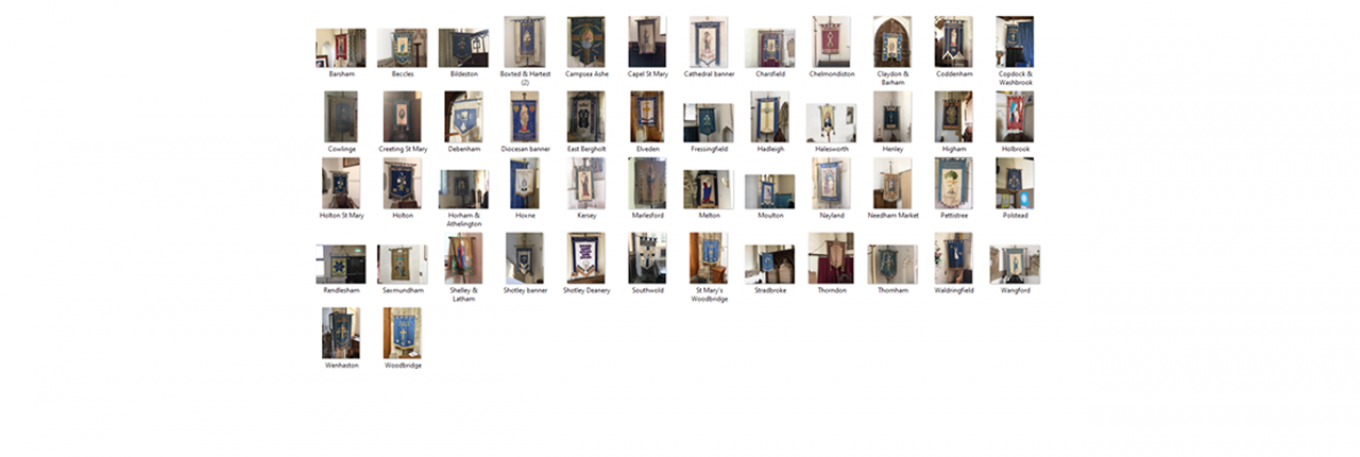You are here

I-Spy an MU Banner!
Where have all the banners gone?
We set a challenge to all our branches in the diocese of St Edmundsbury and Ipswich to find and photograph as many Mothers’ Union Banners as possible during the month of August, in the school holidays. And we are delighted to announce that the winners of the “I-Spy an MU Banner Competition” are the members of the East Bergholt Branch. Congratulations! The runners-up, a very close second (only 1 point in it) were the Campsea Ashe Benefice Branch. Thank you to everyone who sent in photographs from their churches.
All 50 different Banners were spotted around the diocese (with only 4 duplicate pictures). It was disappointing to see the number of churches which obviously have to be locked during the daytime, and others where MU banners could have been expected, they were no longer in evidence. But if there is an MU banner in your church in our diocese, and we haven’t yet been able to visit or take a picture, we would be really grateful if you could send a photograph to dpmusuffolk@gmail.com. Although too late for our competition, it would be lovely to have a comprehensive record of their whereabouts. Some of the photos show banners over 100 years old, and it’s amazing to see the variety of designs – from Madonna and Child to a contemporary appliqued Spiro graphed flower design. We’ve spotted traditional, modern, artistic, evocative, intricate and simple versions all reflecting the identity of branch or deanery. All the pictures to date can be accessed on our Facebook page at MU Suffolk Facebook Album.
So, why are our MU Banners so important? Strangely, not much has been written about them, and there are relatively few images on websites. Banners emerge from an age which we can watch on archive film showing the Suffragettes and the great stirrings of Trade Unionism. But whilst our banners have some things in common with those of other organisations, they also proclaim something of our beliefs and our principles which over the years have changed very little. They are “Banners – with ministry”!
Groups of people have, in the past, used their banners to proclaim their identity. By doing this publicly, it means that we cannot hide in anonymity. In the UK, Mothers’ Union members may not have had the distinctive clothing like the Suffragettes, or the “uniforms” we have so often seen worn overseas – although some of us sometimes manage a scarf or badge! But, even today our banners still have a public proclamation. On a recent visit Sheran Harper, the new Worldwide President, was delighted to be welcomed off the train by a bevvy of banners (what is the collective noun?) at Peterborough Station. To see the MU Banners paraded on such occasions, at Lady Day services and other special events, is indeed an impressive spectacle.
In her excellent “History of the Mothers’ Union” (2009), Cordelia Moyse offers a summary of the evolution of the style of our banners (p.108). Whilst she points out the possible theological inferences of depicting the Madonna and Child, the important emphasis is that our banners portray the ideals of compassion and caring. Even if the general public can no longer recognise the mother and baby as Mary and Jesus, is there not still a need to show that at the heart of Mothers’ Union we value our roots and traditions? These concepts, over time, have gradually become eroded and instead we ask what is power? Accountability? Responsibility? War and peace and economic cycles in our country have put an emphasis on strength and innovation rather than on gentleness and kindness – what kind of influence do our Banners have? How does God see influence and power? Maybe it’s the baby we see in the arms of the Madonna, or perhaps the man, falsely accused, being crucified?
Has the time come to re-think our Banners – pennants, flags, nylon tear-drops or digital representations? Are they still relevant? What do they mean in today’s context? Of course, our perception may well have been affected by the way that the Suffragettes wanted the right to vote, and the way that Trade Unions wanted the right to organise, but if one could summarise the subtext of the MU Banner, what would it be?
We need to be more imaginative. Some of our banners are over 100 years old, and perhaps many are frayed and worn, and beyond repair; others too heavy and unwieldy for convenience, and indeed, even before the First World War, Moyse records that the central Mothers’ Union banner had to be carried by a man! Our own Diocesan Banner is now in need of restoration; our Branch banner stands 8’ tall with a heavy and unwieldly oak pole, cords and tassels…. a challenge for any banner-bearer.
So, where to now? What happens to old banners? Should they be framed behind glass and hung in our churches? Professionally conserved and restored, or wrapped in plastic and left in the chancel? Perhaps replaced with contemporary designs, or locked away in Archive Departments in the Cathedral or Record Office? With what can they be replaced – light-weight silk, nylon, PVC, mesh, nylon tear-drop or feather flags (as seen outside garages), table-top pennants, roller banners, pop-ups, modern-day printed flags digitally produced, - the list goes on and on? Or maybe you feel that Banners have had their day?
How do you see things moving forward?
Written by Linda Ginn
Diocesan President
Click here for more stories from the St Edmundsbury and Ipswich Diocese
